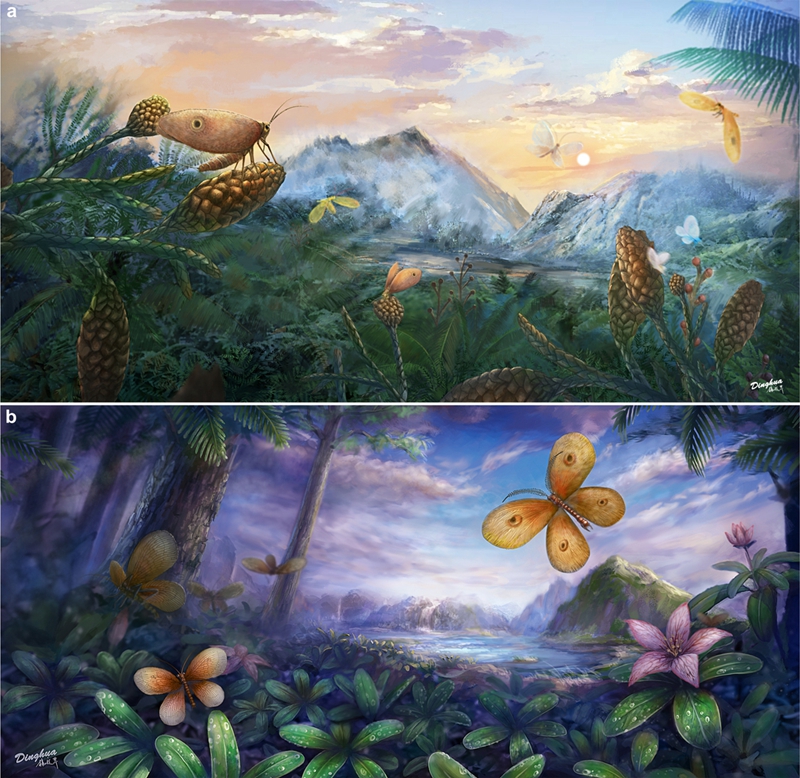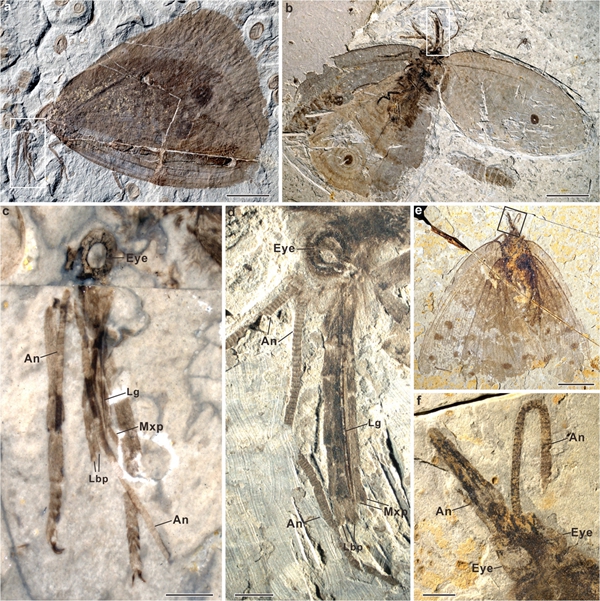
Ecological restoration of kalligrammatids. a, Jurassic kalligrammatids in the Daohugou forest. b, Cretaceous kalligrammatids in the Burmese amber forest (image by YANG Dinghua)
Romeo and Juliet, a romantic but sentimental love story happened in Italy. Now there is a more ancient version, which happened between gymnosperm and pollinating lacewings described as “butterflies of the Jurassic”.
Insect pollination played an important role in the evolution of angiosperms. Little is known, however, about ancient pollination insects and their niche diversity during the pre-angiosperm period due to the rarity of fossil evidence of plant–pollinator interactions.
Recently, a research group led by Prof. WANG Bo from the Nanjing Institute of Geology and Palaeontology of the Chinese Academy of Sciences (NIGPAS) provide new insight into the niche diversity, chemical communication, and defence mechanisms of Mesozoic pollinating insects. This research was recently published in Nature Communications on September 17th, 2018.
One of the most intensely investigated examples of pollination niches is the morphological match between the insect proboscis and floral tube length originated from Darwin’s publication in 1877. Kalligrammatid lacewings are among the largest and most conspicuous Mesozoic insects with siphoning mouthparts. The researchers from NIGPAS reported 27 well-preserved kalligrammatids from late Cretaceous Burmese amber (99 million years ago) and Chinese Early Cretaceous (125 million years ago) and Middle Jurassic (165 million years ago) compression rocks.

Jurassic and Cretaceous kalligrammatids from China.
The lengths of kalligrammatid proboscides vary greatly, from 0.6 to 3.2 mm in amber inclusions and from approximately 5 to 18 mm in compression fossils. The high diversity of kalligrammatids and large variation in their proboscis lengths strongly suggest diverse plant hosts with different floral tube lengths and pollination niche partitioning may have been present among some Mesozoic insects. If pollination niches were partitioned, as in extant ecosystems, this likely increased pollination effectiveness and reduced costs in pollination mutualisms, thus contributing to the high diversity of pollinating insects and the success of pollinator-dependent plants during the Cretaceous period.
Kalligrammatid species diversification was potentially promoted by coevolution between pollinating kalligrammatids and their host plants under highly partitioned pollination niches. Traits such as wing eyespots, which likely functioned as a defence in large-sized species, and sexually dimorphic antennae, which were likely used for pre-mating chemical communication, elucidate how kalligrammatids survived in the Mesozoic terrestrial ecosystem under intense competition.
However, such elaborate associations between kalligrammatids and their host plants (mostly confined to gymnosperms) could have been a main factor contributing to the extinction of kalligrammatids, which likely occurred during the late Cretaceous with the decline in gymnosperm diversity.
Reference: Liu Qing, Lu Xiumei, Zhang Qingqing, Chen Jun, Zheng Xiaoting, Zhang Weiwei, Liu Xingyue*, Wang Bo*(2018) High niche diversity in Mesozoic pollinating lacewings.Nature Communications, 9: 3793. DOI:10.1038/s41467-018-06120-5
Download:
